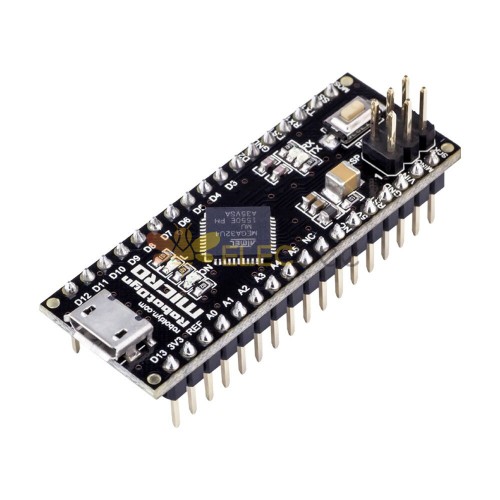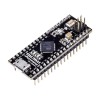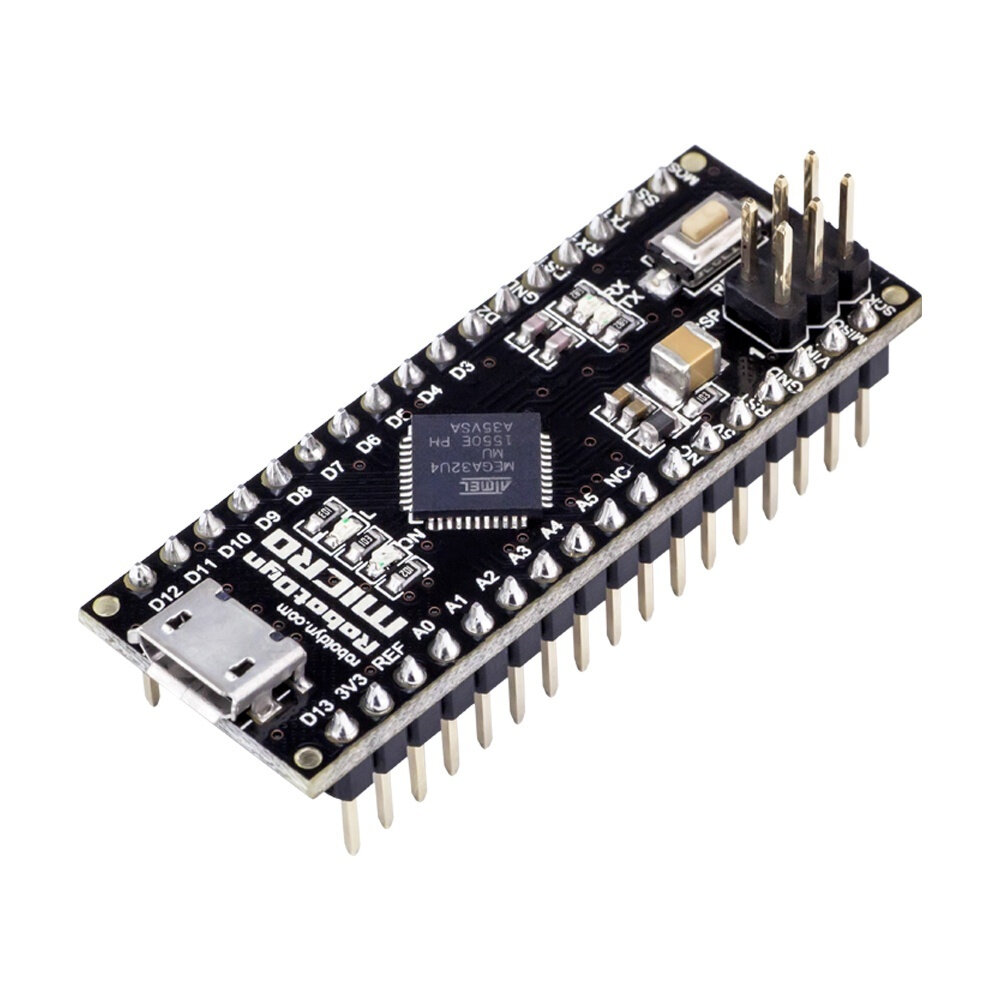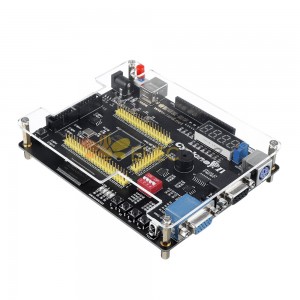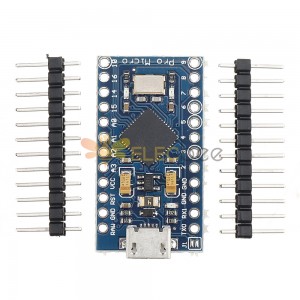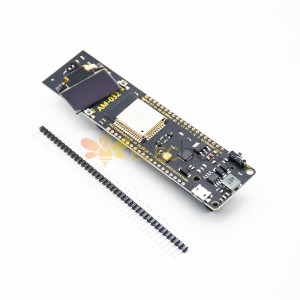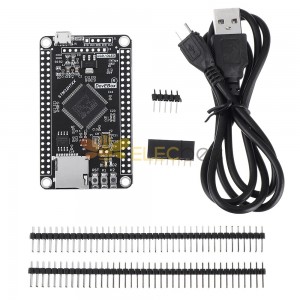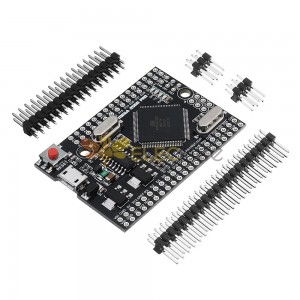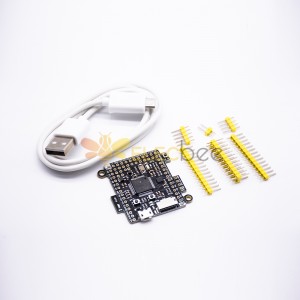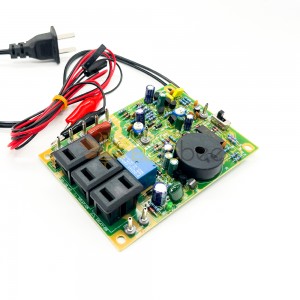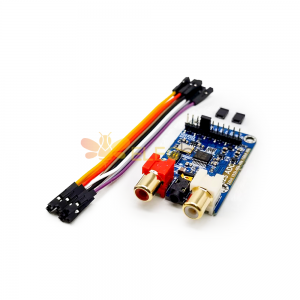Description:
The Micro ATmega32U4-MU is a tiny microcontroller board based on the ATmega32U4. It has 20 digital input/output pins (7 of which can be used as PWM outputs and 12 as analog inputs), a crystal oscillator, a micro-USB connection, an ICSP header and a reset button. With a 16 MHz frequency and 5V operating voltage, this board is similar to the Arduino Leonardo, although the Micro ATmega32U4-MU is more compact (17.78×48.26mm).
The board contains everything needed to support the microcontroller; you just have to connect it to a computer and get started! Its form factor enables it to be easily placed on the circuit board.
Like the Arduino Leonardo, the Micro ATmega32U4-MU has built-in USB connection, eliminating the need for a converter. This allows the Micro to appear to a connected computer as an HID-device, such as a keyboard or mouse, in addition to a COM-port. The board is also able to perform other Arduino Leonardo functions.
Power:
The Micro ATmega32U4-MU can be powered via a USB connection.
Power Supply:
5V: The regulated power supply used to power the microcontroller and other components on the board. This can come either from VIN via a voltage regulator, or be supplied via USB, or another regulated 5V supply.
3V3: A 3.3V supply generated by the on-board regulator. Maximum current draw is 50mA.
GND: Ground pins.
I/O Pins:
Each of the 20 digital pins can be used as an input or output. They operate at 5V. Each pin can provide or receive a maximum of 40 mA, and has an internal pull-up resistor (disconnected by default) of 20-50 k Ohms. In addition, some pins have additional functions:
-- Serial interface: 0(RX) and 1(TX) pins. Used to receive (RX) and transmit (TX) data using the ATmega32U4 hardware serial capability. Note that on the Micro ATmega32U4-MU, the Serial class refers to USB (CDC)-communication, for data transfer on pins 0 and 1, use the Serial1 class.
-- TWI: 2 (SDA) and 3 (SCL) pins. Support TWI (12C) communication using the Wire library.
-- External interrupts: 3 (interrupt 0), 2 (interrupt 1), 0 (interrupt 2), 1 (interrupt 3) and 7 (interrupt 4). These pins can be configured to trigger an interrupt on a low value, a rising or falling edge, or a change in value. See the attachInterrupt() function for details.
-- PWM: 3, 5, 6, 9, 10, 11 and 13. Provide 8 bit PWM output with the analogWrite() function.
-- SPI: on the ICSP header. These pins support SPI communication using the SPI library. Note that the SPI pins are not connected to any of the I/O pins as they are on the Arduino Uno. They are only available on the ICSP connector.
-- Analog inputs: A0 — A5, A6 — A11 (on digital pins 4, 6, 8, 9, 10 and 12). The Micro ATmega32U4-MU has 12 analog inputs (A0 — A11), all of which can also be used as digital i/o. Analog inputs A0 — A5 appear in the same locations as on the Arduino Uno; inputs A6 — A11 are on digital i/o pins 4, 6, 8, 9, 10 and 12, respectively. Each analog input provide 10 bits of resolution (1024 different values). By default, the analog inputs measure from 0 to 5 volts, though it is possible to change the upper end of their range using the AREF pin and the analog Reference() function.
-- Reset. A low signal level resets the microcontroller.
LEDs:
* RX and TX — flash when data is being transmitted via USB connection.
* ON — power indicator.
* L — LED connection to digital pin 13.
Memory:
The ATmega 32U4 microcontroller has 32 KB memory (with 4 KB used by the bootloader). It also has 2.5 KB SRAM and 1 KB EEPROM (which can be read and written with the EEPROM library).
The Micro ATmega32U4-MU has a number of facilities for communicating with a computer, another Arduino device or microcontrollers.
The ATmega32U4 provides serial UART TTL serial communication, which is available on digital pins 0(RX) and 1(TX).
Having hardware support for USB, the ATmega32U4 also allows for serial communication with the computer over a virtual COM port.
The Micro ATmega32U4-MU also acts as a USB 2.0 device, using standard USB COM drivers. The Arduino software includes a serial monitor that allows simple textual data to be sent to and from the board. Which we will do in the example given under the description.
A SoftwareSerial library allows for serial communication on any of the ATmega32U4-MU’s digital pins.
The ATmega32U4 also supports I2C (TWI) and SPI communication. The Arduino software includes a Wire library to simplify use of the 12C bus. The SPI library can be used for SPI communication.
Programming:
The board can be programmed with Arduino software, by selecting ATmega32U4 in the Board menu.
The ATmega32U4 microcontroller on the Micro ATmega32U4-MU comes preburned with a bootloader that allows you to upload new code to it without the use of an external hardware programmer.
You can also bypass the bootloader and program the microcontroller through the ICSP (In-Circuit Serial Programming) header.
Automatic Reset:
Rather than requiring a physical press of the reset button before an upload, the Micro ATmega32U4-MU is designed in a way that allows it to be reset by Arduino software running on a connected computer. The reset is triggered when the virtual CDC COM port is opened at 1200 baud and then closed. When this happens, the processor will reset, breaking the USB connection to the computer. After the processor resets, the bootloader starts, remaining active for about 8 seconds. The bootloader can also be initiated by pressing the Reset button. Note that when the board first powers up, it will jump straight to the user sketch, if present, rather than initiating the bootloader.
USB Overcurrent Protection:
The Micro ATmega32U4-MU has a resettable polyfuse that protects the computer’s USB ports from shorts and overcurrent. Although most computers have their own internal protection, the fuse provides an extra layer of protection. If more than 500mA is applied to the USB port, the fuse will automatically break the connection until the short or overload is removed.| Microcontroller | ATmega32U4-MU |
| Power Out | 3.3V-180mА |
| 5V-800mА |
| Power IN. USB | 5V |
| Power IN. VIN/DC Jack | 5V |
| Power Consumption | 5V 220mA |
| Logic Level | 5V |
| USB | Micro USB |
| Clock Frequency | 16MHz |
| Operating Supply Voltage | 3.3V |
| Digital I/O | 20(7-PWM) |
| Analog I/O | 12 |
| Data RAM Type/Size | 2.5Kb |
| Data ROM Type/Size | 1Kb |
| Interface Type | ISP |
| Operating temperature | −40С°/+85С° |
| PCB size (L×W) | 48.26×17.78mm |
| Weight | 8.5g |
Documents:
1 x Micro ATmega32U4 5V 16MHz Development Board
